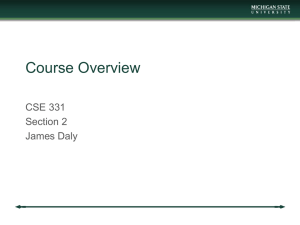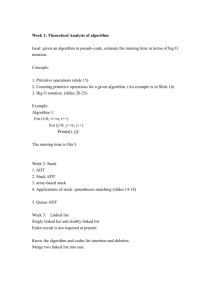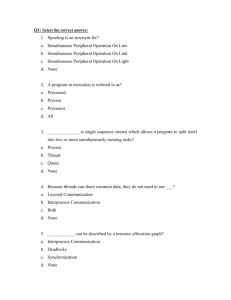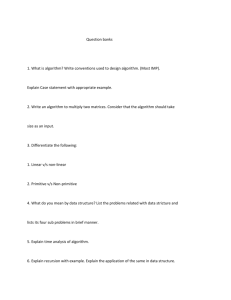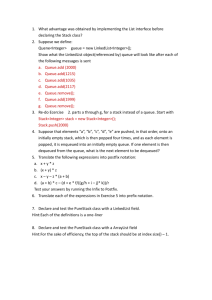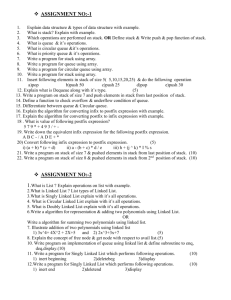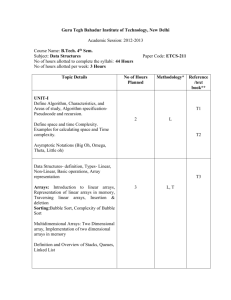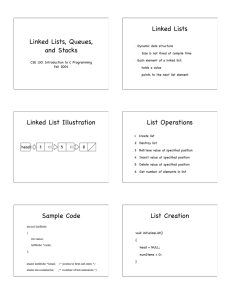- Allama Iqbal Open University
advertisement
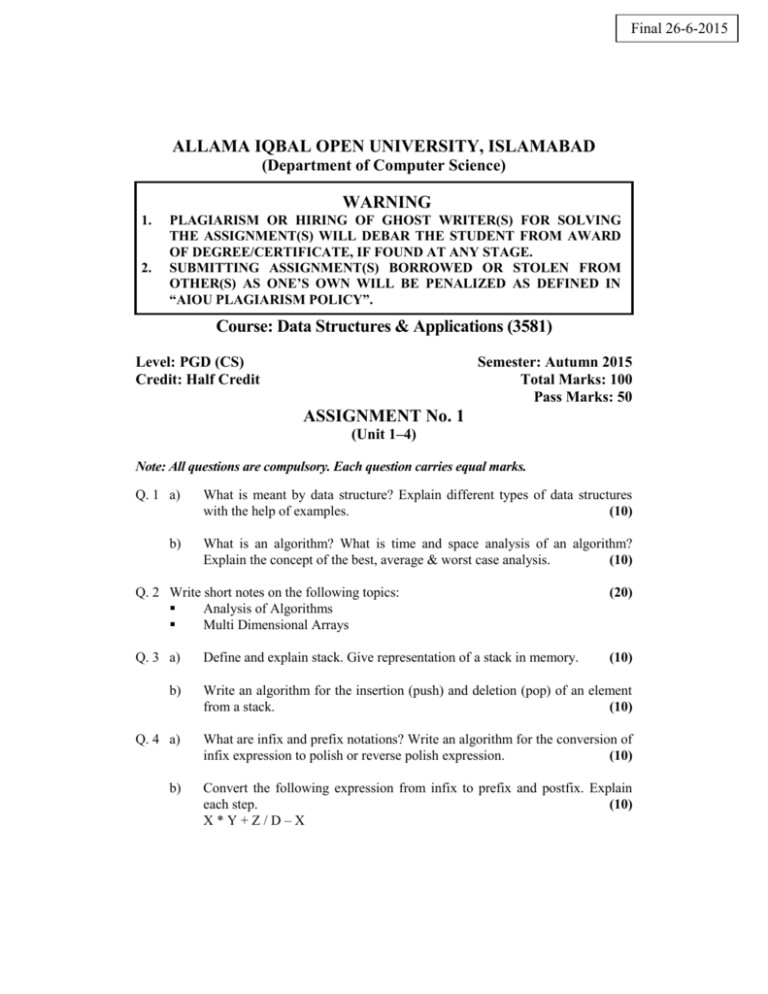
Final 26-6-2015 ALLAMA IQBAL OPEN UNIVERSITY, ISLAMABAD (Department of Computer Science) WARNING 1. 2. PLAGIARISM OR HIRING OF GHOST WRITER(S) FOR SOLVING THE ASSIGNMENT(S) WILL DEBAR THE STUDENT FROM AWARD OF DEGREE/CERTIFICATE, IF FOUND AT ANY STAGE. SUBMITTING ASSIGNMENT(S) BORROWED OR STOLEN FROM OTHER(S) AS ONE’S OWN WILL BE PENALIZED AS DEFINED IN “AIOU PLAGIARISM POLICY”. Course: Data Structures & Applications (3581) Level: PGD (CS) Credit: Half Credit Semester: Autumn 2015 Total Marks: 100 Pass Marks: 50 ASSIGNMENT No. 1 (Unit 1–4) Note: All questions are compulsory. Each question carries equal marks. Q. 1 a) What is meant by data structure? Explain different types of data structures with the help of examples. (10) b) What is an algorithm? What is time and space analysis of an algorithm? Explain the concept of the best, average & worst case analysis. (10) Q. 2 Write short notes on the following topics: Analysis of Algorithms Multi Dimensional Arrays (20) Q. 3 a) (10) Define and explain stack. Give representation of a stack in memory. b) Write an algorithm for the insertion (push) and deletion (pop) of an element from a stack. (10) Q. 4 a) What are infix and prefix notations? Write an algorithm for the conversion of infix expression to polish or reverse polish expression. (10) b) Convert the following expression from infix to prefix and postfix. Explain each step. (10) X*Y+Z/D–X Q. 5 a) Define and explain queue, de-queue and priority queue. Give memory of representation of simple queue, de-queue (circular queue) and priority queue. (10) b) Write an algorithm for the insertion (QINSERT) and deletion (QDELETE) of an element from a queue. (10) ASSIGNMENT No. 2 (Unit 5–8) Total Marks: 100 Pass Marks: 50 Note: All questions are compulsory. Each question carries equal marks. Q. 1 a) What is meant by linked list? Explain it in detail with the help of examples. (10) b) What are the different types of linked list? Give representation of a linked list in memory. (10) Q. 2 a) b) Define and explain tree with the help of examples. (10) Write an algorithm for the pre-order and in-order traversal of binary tree. Illustrate with the help of figures. (10) Q. 3 Give trace of following sort algorithms by using one suitable example for each. (20) a) Selection Sort b) Insertion Sort Q. 4 a) b) Give trace of Binary search algorithm by using a suitable example. (10) Write short notes on the following topics: Binary Search Sequential Search (10) Q. 5 a) What is a graph and what are its types? Give matrix and adjacency list representation of an example graph in memory. (10) b) Give and explain each step with graph example for the trace of depth first search graph traversal algorithm. (10) 2 3581/3425 (Old) Data Structure & Applications Recommended Book: An Introduction to Data Structures By Trembly Course Outlines: Unit No.1 Introduction a) Basic Terminologies b) Introduction to Data Structures c) Data Structure (Classification, Types, Operation) d) Basics of Algorithms, Notation used e) Importance of Algorithms for Optimized Application Development f) Introduction to Analysis of Algorithms Unit No.2 Arrays a) Arrays (Definition and Examples) b) Representation of array in Memory. c) Accessing & Traversing Array, Inserting & Deleting d) Multi Dimensional Arrays & their Representation in Memory. Unit No.3 Stacks a) Stack, Importance of Stack, Array Representation of Stacks b) Stack Operations (PUSH and POP operations) c) Infix, Postfix and Prefix Expressions Unit No.4 Queues a) Queue, Representation of Queues b) Operation Perform on Queue (Inserting and Removing Nodes) c) De-queues, Priority queues Unit No.5 Linked Lists a) Linked Lists Concept, Representation of Linked Lists in Memory b) Traversing & Searching a Linked List, Insertion & Deletion in Linked List c) Types of Linked Lists 3 Unit No.6 Trees a) Tree b) Tree Types (Simple, Binary, General) c) Representation of Binary Tree in Memory d) Traversing (Pre order, In order, Post order). e) Basic Operation (Insertion Deletion). Unit No.7 Sorting & Searching a) Bubble Sort, Quick Sort, Insertion Sort, Selection Sorting b) Sequential Search, Binary Search Unit No.8 Graphs a) Graph Theory Terminology, Linked Representation of Graphs b) Directed and Undirected Graphs, Traversal Methods Unit No.9 Files and Data Storage a) Basic Operations on Different Files Organizations b) Add, Update and Delete Record c) File Organizations 1. Sequential 2. Indexed Sequential 3. Direct (Hashing) 4. Merging Files 4
